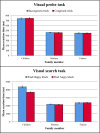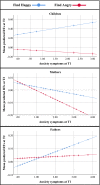Intergenerational transmission of attentional bias and anxiety
- PMID: 30428152
- PMCID: PMC6590262
- DOI: 10.1111/desc.12772
Intergenerational transmission of attentional bias and anxiety
Abstract
Earlier evidence has revealed a bi-directional causal relationship between anxiety and attention biases in adults and children. This study investigated the prospective and concurrent relations between anxiety and attentional bias in a sample of 89 families (mothers, fathers, and first-born children). Parents' and children's attentional bias was measured when children were 7.5 years old, using both a visual probe task and visual search task with angry versus happy facial expressions. Generalized and social anxiety symptoms in parents and children were measured when children were 4.5 and 7.5 years old. Anxiety in parents and children was prospectively (but not concurrently) related to their respective attentional biases to threat: All participants showed a larger attentional bias to threat in the visual search (but not in the visual probe) task if they were more anxious at the 4.5 (but not at the 7.5) year measurement. Moreover, parents' anxiety levels were prospectively predictive of the visual search attentional bias of their children after controlling for child anxiety. More anxiety in mothers at 4.5 years was related to a faster detection of angry among happy faces, while more anxiety in fathers predicted a faster detection of happy among angry faces in children at 7.5 years. We found no direct association between parental and child attentional biases. Our study contributes to the recently emerging literature on attentional biases as a potential mechanism in the intergenerational transmission of anxiety by showing that parents' anxiety rather than parents' attentional bias contributes to the intergenerational transmission of risk for child anxiety.
Keywords: anxiety; attentional bias; fathers; visual probe task; visual search task.
© 2018 The Authors. Developmental Science Published by John Wiley & Sons Ltd.
Figures




References
-
- Aktar, E. , Majdandžić, M. , de Vente, W. , & Bögels, S.M. (2013). The interplay between expressed parental anxiety and infant behavioural inhibition predicts infant avoidance in a social referencing paradigm. Journal of Child Psychology and Psychiatry, 54, 144–156. 10.1111/j.1469-7610.2012.02601.x - DOI - PubMed

